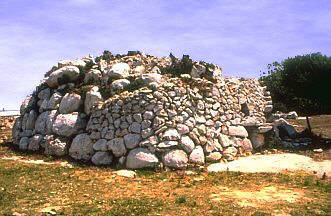

With the name of "naveta" it is known a type of burial tomb (although they also exist "habitable navetas") characterized by its form of hull of overturned ship. In fact, not all the "navetas" present an apsidal plan as clear as their name indicates, but the most famous, as the one of "Es Tudons", that truly adopts this form, have finished imposing this terminology.
Inheritors of the megalithic constructions, these funerary constructions present an internal structure that remembers that one of the "corridor sepulchres", with a small square door, a corridor and a chamber. The door opens in the facade, which "nautically" would be the "stern" of the ship and that often it is lightly concave, and afford a passage to a corridor that sometimes has a chimney exactly before the perforated flagstone that gives access to the chamber. This last one is usually lengthened and, in occasions, it has a floor to which you accede for the aforementioned chimney. It seems to be that the ground floor was used for the primary burials, while the floor was an ossuary. Structurally, a slight inclination of the walls toward the interior was what allowed the placement of the big flagstones that made the function of roof, or of roof and pavement of the ground floor and the floor, respectively.
Typologically, and leaving aside those habitable (object of a separate section), we distinguish two clearly differentiated groups of "navetas", which probably correspond with two different evolutionary stages: the one of those denominated "of intermediate pattern" and that of those "of elongated plan".